Ambling gaits are 4-beat gaits that are faster than the walk and slower than the gallop. These gaits are smooth because the horse is in contact with the ground at all times. The ambling gaits include Stepping Pace, Flat Foot Walk, Running Walk, Saddle Rack, Rack, and the Fox Trot.
Due to stylistic differences in some breeds, these gaits may also be called Paso Llano, Classic Fino, Paso Corto, Paso Largo, Tolt, Marcha Picada, and Marcha Batida.
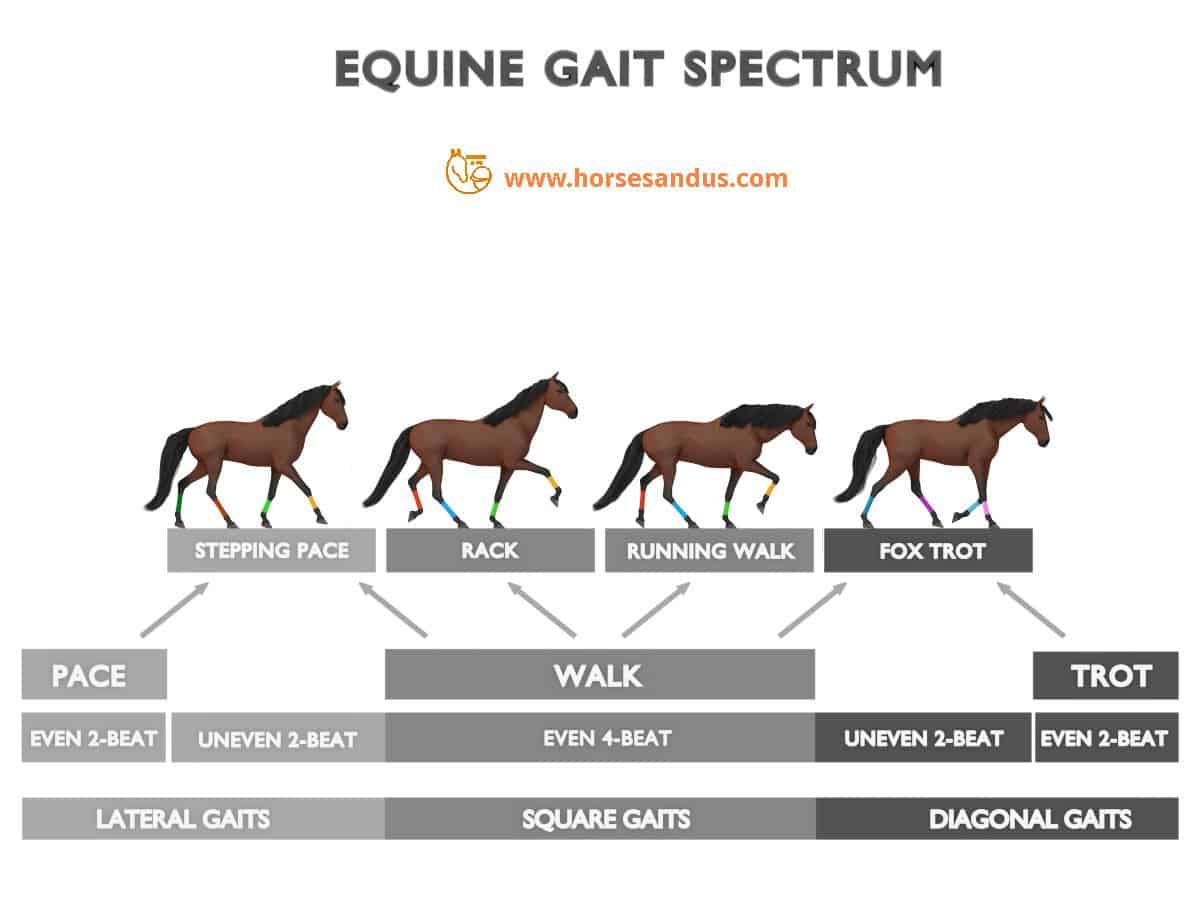
The ambling gaits are much more comfortable to ride than the trot or pace because they do not have a moment of suspension and so the rider does not feel that uncomfortable bang when the horse’s feet drop back on the ground.
Defining The Gaits
Before we get started explaining the different gaits, it’s useful to understand some basic terminology that is used to describe the horse’s movement for each gait.
The ambling gaits are categorized mainly by the following elements:
| Footfall sequence | The sequence of the footfalls as the hose moves. In all ambling gaits, the sequence is the same: LH-LF-RH-RF |
| Footfall timing | The number of beats in a complete stride and the time between each footfall. All ambling gaits are 4-beat, but the time between each footfall can be regular or irregular. |
| Hoof Support Sequence | The different quantity of hooves that are on the ground in a complete stride. These can alternate between 4-foot, 3-foot, 2-foot, 1-foot or 0-foot. This will depend on the gait and also on the speed within the same gait. |
These elements will be different in each gait and will be impossible to see just by looking at the horse in real time. Therefore, in this article, we will explain them by using illustrations and animations.
The Equine Gait Spectrum
Every ambling or intermediate gait falls somewhere between the two extremes of the gait spectrum.
At one end of the spectrum is the completely lateral gait – The Pace.
At the other end of the spectrum is the completely diagonal gait – The Trot
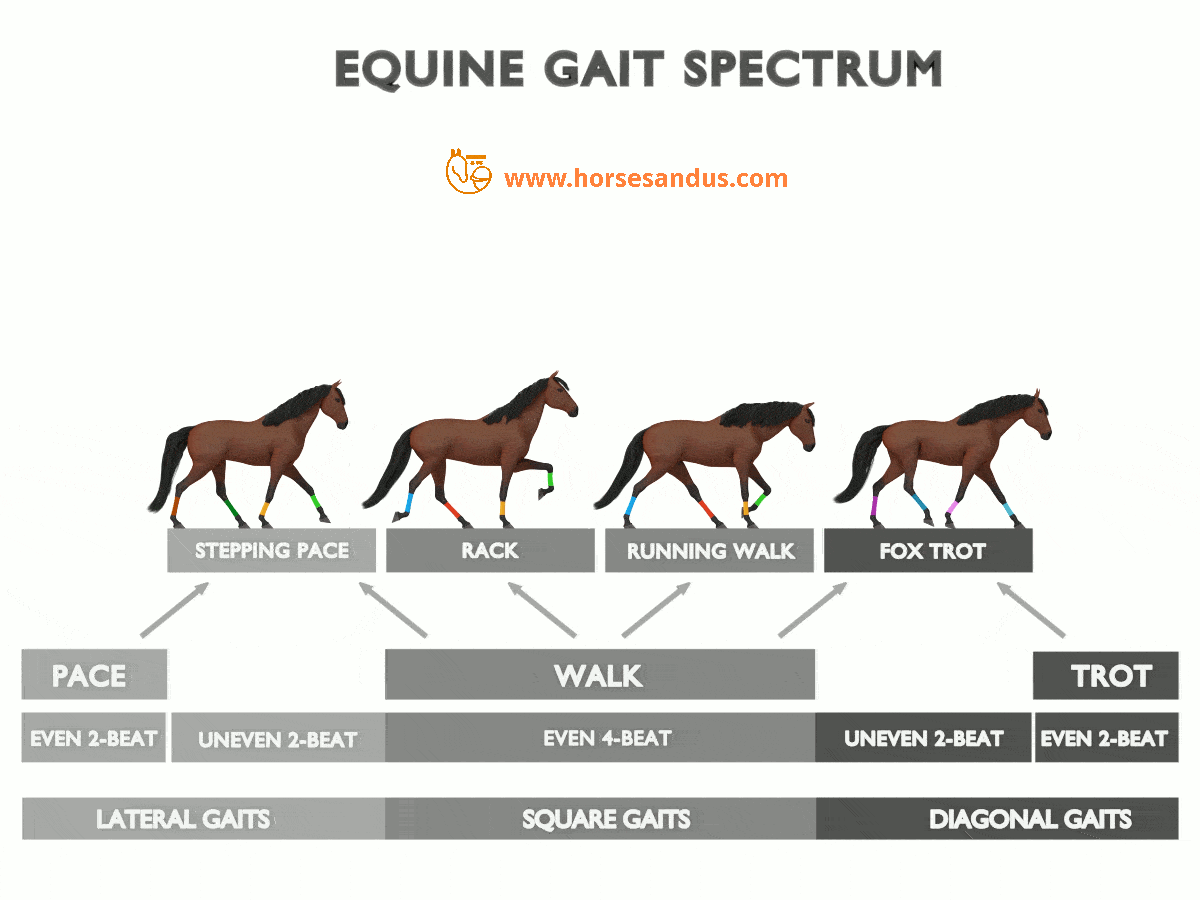
Below is an overview of the horse gaits within the gait spectrum.
Depending on the horse there can be some variation within these gaits. The timing and body movement may be slightly different from horse to horse. Some may tend to be more regular while others more irregular, some pacier than others, the overstride and head nod may vary, and so on.
Next, we will go into the details of each one of the “ambling” gaits.
Stepping Pace
The stepping pace is probably the most common of the ambling gaits.
It is characterized by
- The speed of the stepping Pace ranges from 3 to 15 miles per hour (5 to 24 km per hour)
- It is a comfortable gait that rocks you from side to side in the saddle. This motion may make some people seasick.
- The horse’s head and neck will sway from side to side but not as strong as in the true pace.
- There may be a slight up and down movement of the head. But the croup will remain level.
Stepping Pace Gait Mechanics
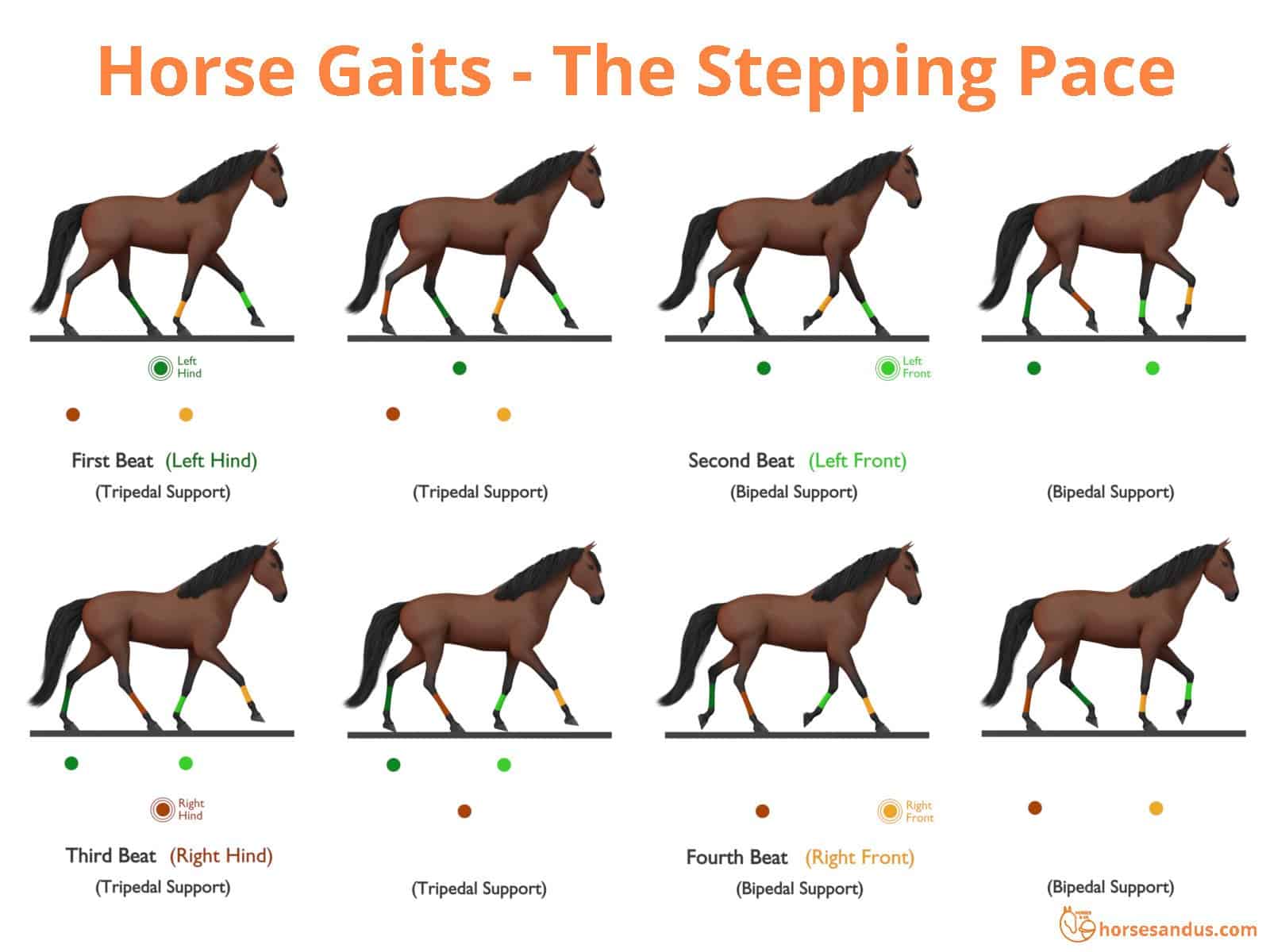
It is considered a lateral gait because the lateral pair of legs leave the ground and move forward at the same time. However, they land at slightly different times.
The footfall sequence is left hindleg, left foreleg, right hindleg, right foreleg.
The footfall Timing is an uneven 4-beat gait.
The lateral hooves lift off the ground together but they do not land together. The hind hoof lands slightly before the front hoof, making it a 4-beat gait, however, all four footfalls are not equally spaced in time, which means the timing is uneven.
The footfalls on the lateral side are closer together in time than on diagonal footfalls. The sound is a broken 1-2, 3-4 beat. (“ka-chunk”, “ka-chunk”).
The support phases alternate between bipedal (2-foot support) and tripedal (3-foot support).
At higher speeds the support phases are bipedal (2-foot support) and unipedal (1-foot support).
Saddle Rack
The Rack is the second most common of the smooth ambling gaits.
It is characterized by:
- The speed of the Saddle Rack ranges from very slow (which is done almost in place) to about 8 miles per hour (13 km per hour)
- Very comfortable to ride, with a slight side to side sway.
- The head is carried high and steady with only slight nodding.
- The croup rises and falls with a sharp flexing of the hocks.
- The tail bobs up and down with the motion of the croup.
- The front legs have high movement
- There may be capping or even understride. These shorter strides allow the horse to be more balanced making it more suited for going over rough terrain.
Saddle Rack Gait Mechanics

The footfall sequence is left hindleg, left foreleg, right hindleg, right foreleg.
The footfall Timing is an even 4-beat gait with the four footfalls equally spaced in time.
The sound is an even 1-2-3-4 beat (“taka”, “taka”)
The support phases alternate between bipedal (2-foot support) and tripedal (3-foot support).
The Rack
The Rack or true Rack is basically the same as the saddle rack but is much faster.
It is characterized by:
- The speed of the Rack can go up to 30 miles per hour (48km per hour)
- Comfortable to ride, with a slight side to side sway.
- The head is carried high and steady with only slight nodding.
- The croup rises and falls with a sharp flexing of the hocks.
- The tail bobs up and down with the motion of the croup
- The front legs have high movement
- There is some overstride in the rack but usually not as much as in the running walk.
- This gait is suited for going over rough terrain.
Rack Gait Mechanics
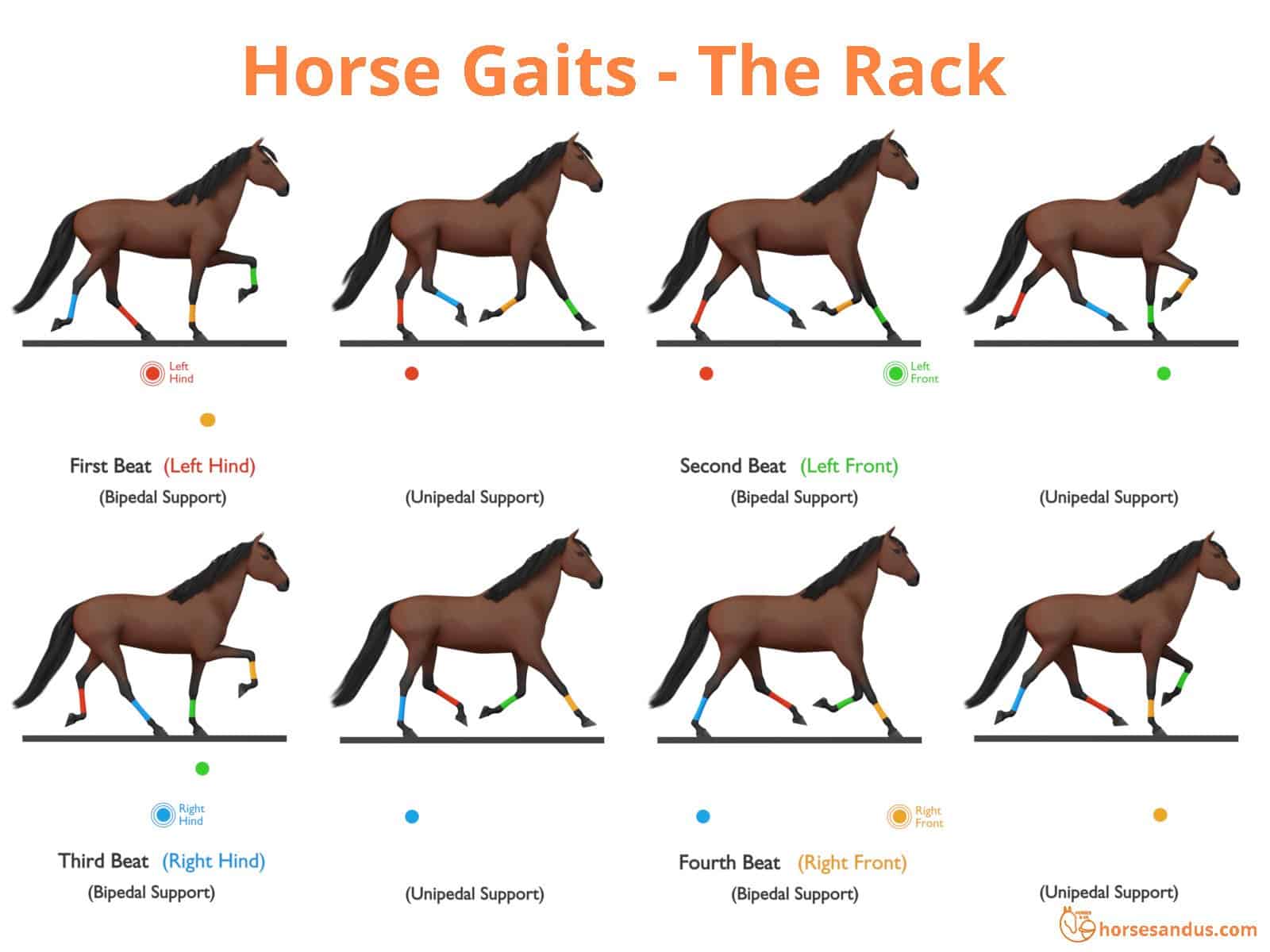
The footfall sequence is left hindleg, left foreleg, right hindleg, right foreleg.
The footfall Timing is an even 4-beat gait with the four footfalls equally spaced in time.
The sound is an even 1-2-3-4 beat (“taka”, “taka”)
The support phases alternate between bipedal (2-foot support) and unipedal (1-foot support).
There is never a moment when both front hooves are simultaneously in contact with the ground and the same applies to the hind hooves.
The Flat Foot Walk
The flat foot walk or flat walk is identical to the walk but faster, more energetic, and long-reaching
It is characterized by:
- The speed of the flat foot walk is from 4 to 8 miles per hour (6.4 to 12.8 km per hour).
- Usually more comfortable to ride than the regular walk
- High-stepping forelimbs with an extended reach.
- Overstriding with the hind foot overreaching the fore foot imprint up until 14 inches (35 cm )
- Head-and-neck nodding in rhythm with the feet
- Relaxed ears flicking forward and backward
- The croup remains level
- The back does not undulate as much as in the walk
- The Horse appears energetic but relaxed.
- This gait is suited for riding in flat terrain.
Flat Foot Walk Gait Mechanics
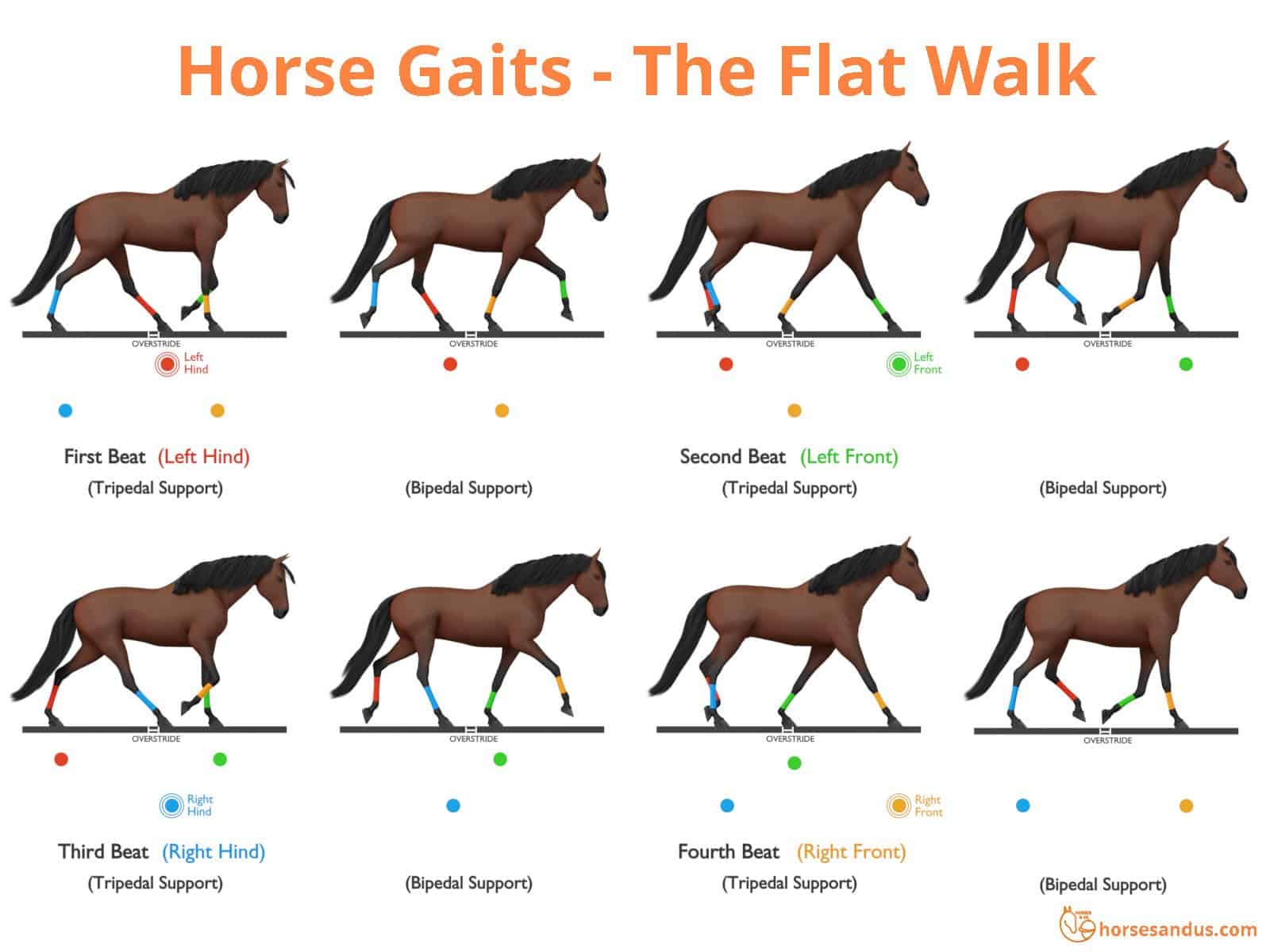
It is considered a square gait because the lateral pair of legs leave the ground, move forward, and land at different times with equal intervals.
The footfall sequence is left hindleg, left foreleg, right hindleg, right foreleg.
The footfall Timing is an even 4-beat gait with the four footfalls equally spaced in time.
Each hoof moves independently from the other three. There is no lateral or diagonal pairing in timing.
The sound is an even 1-2-3-4 beat (“taka”, “taka”)
The support phases alternate between bipedal (2-foot support) and tripedal (3-foot support).
Running Walk
The running walk is basically a more powerful version of the flat foot walk. This is the typical gait of the Tennessee Walking Horse breed.
It is characterized by:
- The speed ranges from 10 to 20 miles per hour (16 to 32 km per hour).
- Is comfortable to ride, being ideal for the flat terrain
- There is more push from behind than in the flat walk, with an increased overstride up to 24 inches (61cm).
- The head-and-neck nodding is faster due to increased speed.
- The front legs move higher than in the flat walk
- This gait is suited for riding in flat terrain.
Running Walk Gait Mechanics
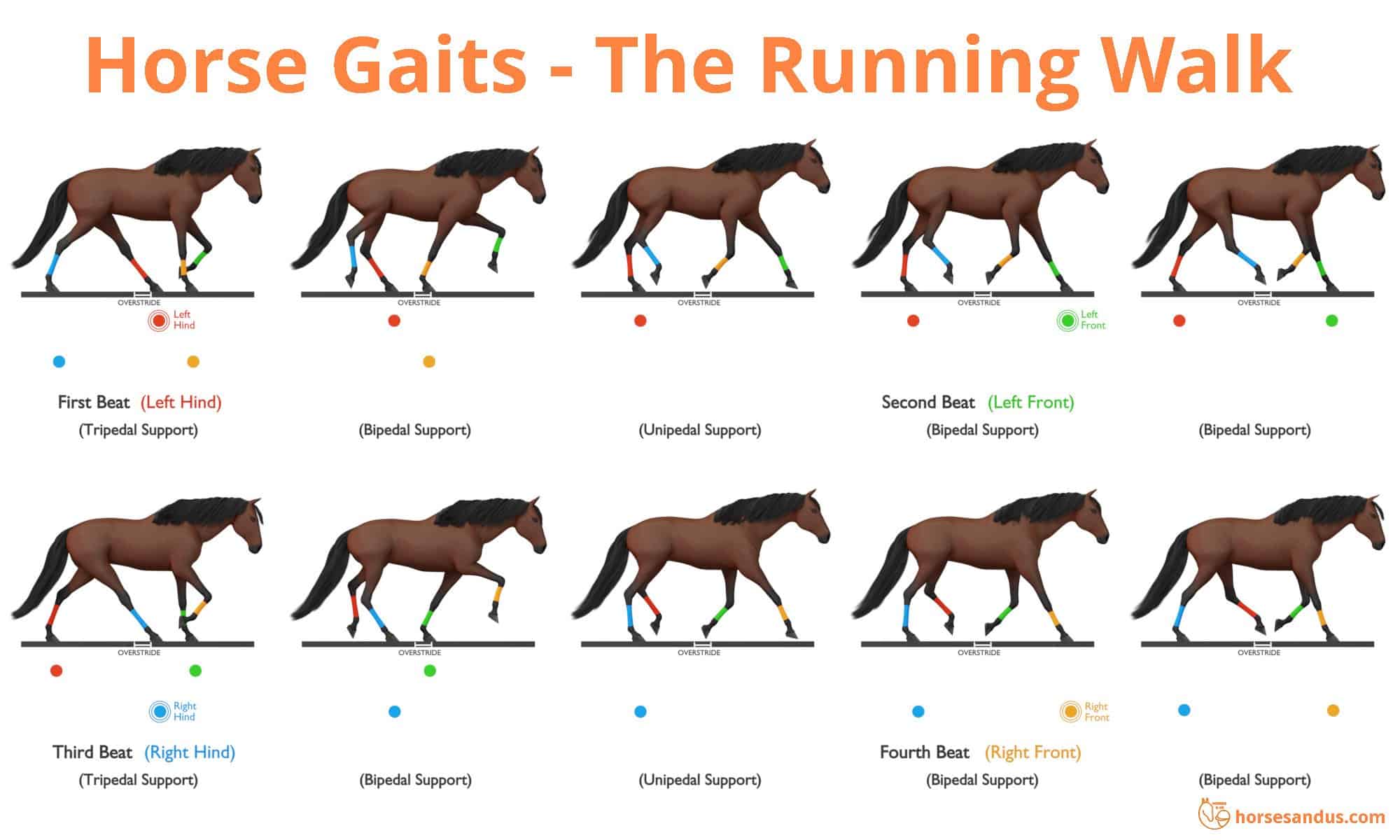
It is considered a square gait because the lateral pair of legs leave the ground, move forward, and land at different times with equal intervals.
The footfall sequence is left hindleg, left foreleg, right hindleg, right foreleg.
The footfall Timing is an even 4-beat gait with the four footfalls equally spaced in time.
Each hoof moves independently from the other three. There is no lateral or diagonal pairing in timing.
The sound is an even 1-2-3-4 beat (“taka”, “taka”)
The support phases can be unipedal (1-foot support), bipedal (2-foot support), and tripedal (3-foot support).
Fox Trot
The Fox Trot is the only diagonal ambling gait. It is similar to the trot but is a “broken” diagonal gait because the diagonal hooves do not land at the same time like in the trot.
It is characterized by:
- The speed ranges from 6 to 10 miles per hour (10 to 16 km per hour)
- At slow speeds it is sometime called the fox walk
- It is comfortable to ride, pushing you from front to back and never from side to side.
- There is some head nod.
- The croup and tail bounce up and down as the hind legs bend sharply at the hocks.
- Has a longer diagonal support during each stride providing more balance for the horse than the more lateral gaits
- The better balance and low concussion make it well suited for rough terrain.
Fox Trot Gait Mechanics
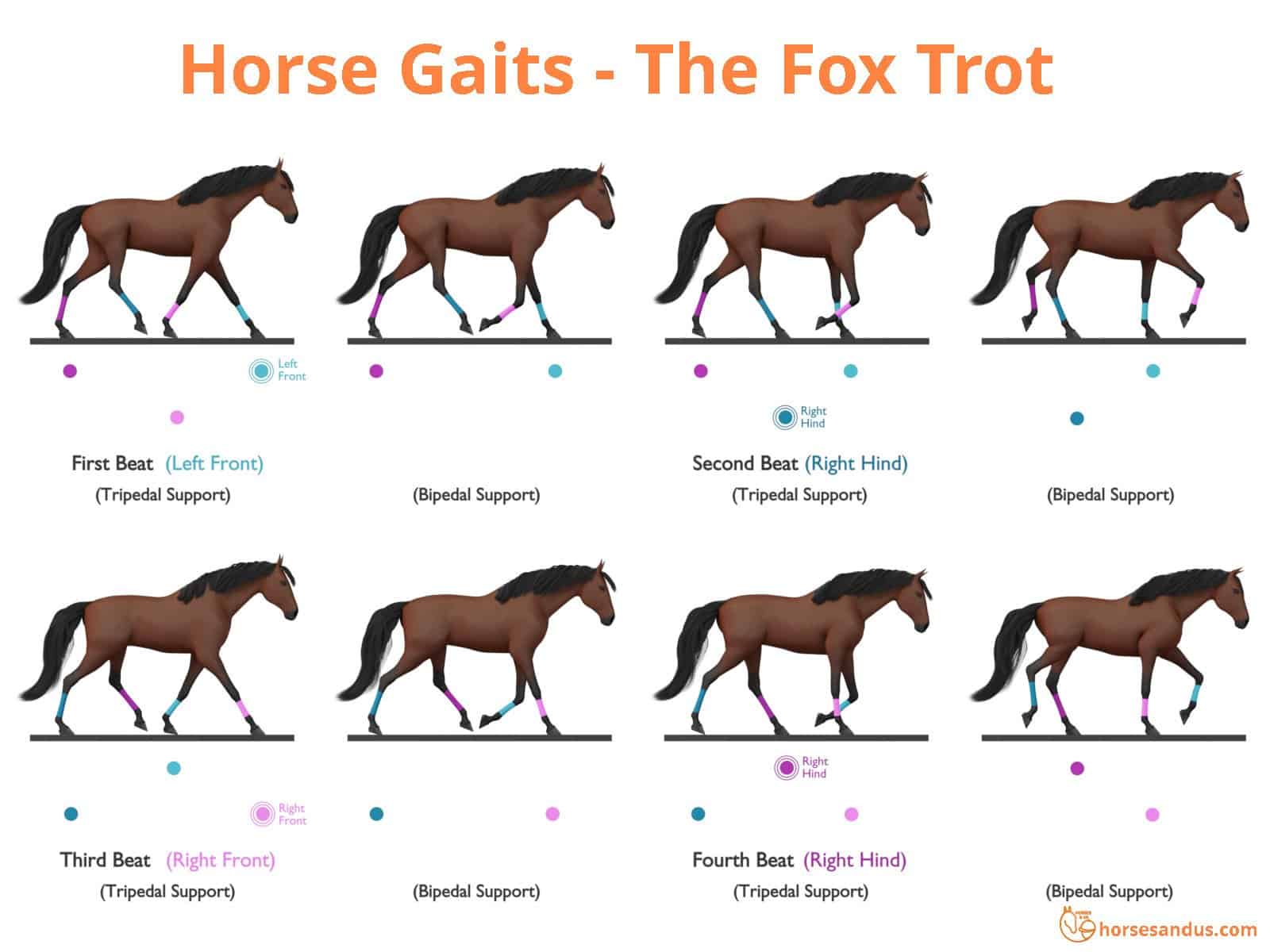
It is considered a diagonal gait because the diagonal pair of hooves pick up and set down closer in time than the lateral hooves.
The footfall sequence is left foreleg, left hindleg, right foreleg, right hindleg .
The footfall Timing is an uneven 4-beat gait.
The front hoof lands slightly before the hind hoof, making it a 4-beat gait; however, all four footfalls are not equally spaced in time, which means the timing is uneven.
The footfalls on the diagonal side are closer together in time than on lateral footfalls. The sound is a broken 1-2, 3-4 beat. (“ka-chunk”, “ka-chunk”,….).
The support phases alternate between bipedal (2-foot support) and tripedal (3-foot support).
At higher speeds the support phases are bipedal (2-foot support) and unipedal (1-foot support). With moments of suspension (0-foot support).
Specific Names for Ambling Gaits by Breed
The ambling gaits may have different names depending on the breed and the characteristic way in which the gait is performed,
The table below maps these different names to the common gait name.
| Gait name | Specific name | Breed |
|---|---|---|
| Flat Foot Walk | Paso llano | Peruvian Paso |
| Running Walk | Paso llano | Peruvian Paso |
| Saddle Rack | Classic Fino | Paso Fino |
| Saddle Rack | Paso Corto | Paso Fino |
| Rack | Paso Largo | Paso Fino |
| Rack | Tolt | Icelandic Horse |
| Stepping Pace | Sobreandando | Peruvian Paso |
| Stepping Pace | Marcha Picada | Mangalarga Marchador |
| Fox Trot | Marcha Batida | Mangalarga Marchador |
The Peruvian Paso Gaits
The Peruvian Paso breed has a very unique way of performing the flat foot walk and running walk, which is called the Paso llano. The stepping pace is also very characteristic of the breed and is called Sobreanando.
Paso Llano
The Paso llano is essentially the same gait as the flat walk (slow Paso llano) or running walk (Paso llano).
It is an even 4-beat gait with four equal beats. It has a 1-2-3-4 rhythm
It has some unique characteristics:
- The head is held in an upright position looking up, with little or no nod.
- The front legs move forward and outward swinging motion, similar to a swimmer’s arms. This movement is called Termino. It should not be confused with “paddling” which is a gait defect.
- Will have less overstride than the flat or running walk.
Sobreandando
The Sobreandando is similar to the stepping pace and faster than the Paso llano.
It is an uneven 4-beat gait with the lateral beats closer together than the diagonal beats. It has a 1-2, 3-4 rhythm.
It has the same stylistic features as the Paso llano, such as the termino and an upright head.
The Paso Fino Gaits
The Paso Fino horse breed has a very unique way of performing the saddle rack which is called the Classic Fino or the Paso Corto depending on the speed. The Running walk is also very unique in this breed and is called the Paso Largo.
Classic Fino
The Classic fino is the hallmark gait of the Paso Fino Horse. It is performed at very slow speeds (almost in place) but with such rapid footfalls that it almost sounds like a drum-roll.
It is technically the same gait as the saddle rack, but performed in a very unique way to the Paso Fino Breed.
The horse has a collected head carriage showing “brio”, i.é proud and energetic.
Very short strides with a low lift of the hooves.
It has a big under stride, where the rear hoof lands a big distance behind the imprint left by the front hoof.
Paso Corto
Is a more relaxed and faster version of the classic fino gait.
The speed is similar to that of the trot.
It is performed in a moderate collection and longer steps.
The Paso Corto is suitable for pleasure and trail riding.
Paso Largo
The Paso Largo is the fastest form of the Paso Fino gaits. It is Paso Fino’s unique version of the running walk.
The speed is similar to that of the rack reaching up to 20 miles per hour (32 km per hour)
It is performed with less collection and longer steps.
The Icelandic Horse Gaits
Tolt
The Tolt is basically the rack with the unique characteristics of the Icelandic horse.
It can be ridden at varying speeds from very slowly up to very fast (20mph /32kph)
To learn more about this horse breed and its gaits check our article about the Icelandic Horse Breed.
Mangalarga Marchador Gaits
The gaits of the Mangalara Marchador are fast and smooth and can be either lateral or diagonal.
Marcha picada
The Marcha Picada is a lateral gait equivalent to the stepping pace.
Marcha Batida
The Marcha batida is a diagonal gait equivalent to the Fox trot.
The Difference Between The Running Walk and The Rack
The running walk and the rack are often confused, but although they are both 4-beat even gaits, they are in fact quite different. The following table shows the main differences.
| Running Walk | Rack | |
|---|---|---|
| Type of Gait | Square Gait | Lateral Gait |
| Hoof pick up and set down | The lateral pair of hooves leave the ground, move forward, and land on the ground at separate times | The lateral pair of hooves leave the ground at the same time, however they touch the ground at separate times. |
| Hoof Tracking | Big overstride. The hind hoof touches the ground in front of the track left by the front hoof. | Usually capping or understride. The hind hoof lands in the same position or before the track left by the front hoof. |
| Head nod | A deep head nod, to maintain balance due to the big overstride, | Shallow head nod. |
Sources
If you are interested in learning more about horse gaits we recommend the following books below.
The links below that lead to products on Amazon are affiliate links and I earn a commission (with no additional cost for you) if you make a purchase.